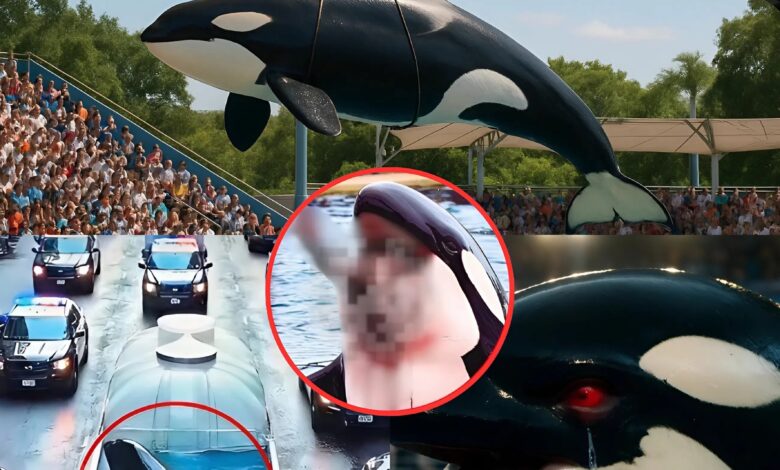TQ. As rescuers chained the grieving killer whale after the tragedy, its final cries echoed so painfully that even they couldn’t hold back tears.

The gray dawn over the harbor was thick with unease. Fog rolled off the water, cloaking the scene in a somber haze, as if nature itself mourned what was about to occur. On the dock, a young killer whale—already at the center of national attention after being left behind by its pod—was being prepared for transport. Its wails, raw and desperate, carried across the water, a sound that pierced the hearts of all who heard it.
Discover more
WordPress themes
Digital advertising space
Football team merchandise
True crime documentaries
Rescue animal adoption
Fashion magazines
Affiliate marketing programs
Police services
Premium news content
Paul Walker memorabilia
For the rescue team, the mission was meant to be routine: secure the whale, ensure its physical safety during transit, and move it to a rehabilitation facility capable of providing long-term care. But no protocol or years of experience could prepare anyone for the visceral reality of the moment. As the heavy chains were secured around the animal, the creature’s cries intensified, echoing with unmistakable sorrow. Observers described the sound as “almost human,” imbued with fear, confusion, and grief—a mournful chorus that demanded empathy.

Discover more
Copyright protection services
Affiliate marketing programs
Disclaimer templates
luggage
Relationship advice books
True crime documentaries
Content creation tools
Portable speakers
News website theme
Royal family biographies
Veteran marine biologist Dr. Evelyn Kim, who had followed the calf since the initial tragedy, recalled, “Even the most seasoned rescuers, those who have worked with orcas for decades, could not hold back tears. The intensity of its cries reflected profound emotional pain—grief for its lost family and a clear understanding that it was being removed from the familiar world it had known.”
Family games
The psychological impact of such a separation cannot be overstated. Killer whales are among the most socially complex creatures on Earth, forming pods that operate as intricate family networks. Calves rely heavily on their mothers and relatives not just for sustenance but for learning vital survival skills and social behaviors. The sudden loss of its pod, combined with human intervention, created a cascade of stress responses in the young whale: frantic swimming, repeated vocalizations, and heightened physiological tension.
Discover more
Copyright protection services
Website design services
Anniversary gifts
True crime documentaries
Animal rescue donations
Website hosting services
Digital advertising space
News site monetization
Newsletter subscriptions
television
Observers and volunteers reported an overwhelming sense of empathy. Some cried openly on the docks; others felt a silent, heavy weight pressing on them as the whale’s mournful calls echoed across the water. Social media amplified the emotional intensity, with videos of the scene going viral and sparking nationwide discussions about ethics, animal welfare, and humanity’s responsibility toward intelligent marine life.
The transport itself was a meticulous, tense operation. The whale was carefully restrained with padded chains to prevent injury, while veterinarians and handlers closely monitored its vital signs. Despite these precautions, the whale’s cries did not abate. As the vehicle slowly departed, the sound seemed to linger in the harbor, a haunting farewell that refused to be ignored.
The incident has since triggered a broader national conversation. Ethicists and animal behaviorists have weighed in, questioning whether human intervention in such circumstances truly serves the animal’s best interests. Advocacy groups are calling for stricter oversight of marine animal transports and better understanding of orca social structures, emphasizing that actions intended to protect can sometimes inadvertently deepen trauma.
Discover more
Celebrity gossip magazines
Website design services
Anniversary gifts
Journalism courses
Fashion magazines
News site monetization
True crime documentaries
television
Football team merchandise
Cleaning supplies
Dr. Kim emphasized a critical point: “This whale’s experience is a stark reminder that these are not simply animals; they are sentient beings capable of complex emotions, memory, and social bonds. Each action we take has consequences far beyond what we can immediately see.”
Beyond the immediate drama of transport, the story resonates on multiple levels. It reflects humanity’s ongoing struggle to reconcile conservation efforts with respect for natural behavior, the emotional depth of non-human creatures, and the consequences of our interventions. The haunting cries of the young killer whale became not only a symbol of suffering but also a call for reflection, urging society to reconsider how we engage with the natural world.
As the whale began its journey toward the rehabilitation facility, those who had witnessed the scene were left with lingering echoes of sorrow and awe. The cries, once a desperate plea for help, now serve as a powerful testament: to the intelligence and emotional capacity of the animal, to the ethical responsibility of humans, and to the profound, often heartbreaking, beauty of life beneath the waves.

This is not merely a story of rescue—it is a story of loss, survival, empathy, and the delicate balance between human intervention and the natural order. It challenges us to confront uncomfortable truths about our impact on the world and reminds us that even the smallest voices of the wild demand to be heard.
